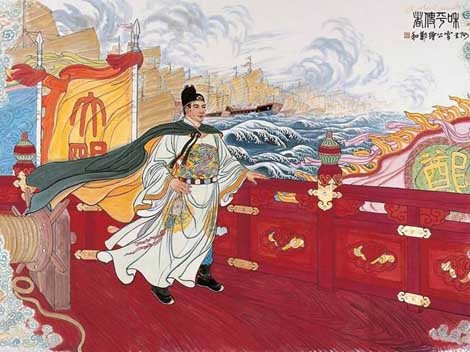These enormous treasure junks were commanded by the great admiral, Zheng He. Together, Zheng He and his armada made seven epic voyages from the port at Nanjing to India, Arabia, and even East Africa.
The First Voyage of Zheng He and the Treasure Fleet
In 1403, the Yongle Emperor ordered the construction of a huge fleet of ships capable of travel around the Indian Ocean. He put his trusted retainer, the Muslim eunuch Zheng He, in charge of construction. On July 11, 1405, after an offering of prayers to the protective goddess of sailors, Tianfei, the fleet set out for India with the newly-named admiral Zheng He in command.
The Treasure Fleet's first international port of call was Vijaya, the capital of Champa, near modern-day Qui Nhon, Vietnam. From there, they went to the island of Java in what is now Indonesia, carefully avoiding the fleet of pirate Chen Zuyi. The fleet made further stops at Malacca, Semudera (Sumatra), and the Andaman and Nicobar Islands.
In Ceylon (now Sri Lanka), Zheng He beat a hasty retreat when he realized that the local ruler was hostile. The Treasure Fleet next went to Calcutta (Calicut) on the west coast of India. Calcutta was one of the world's major trade depots at the time, and the Chinese likely spent some time exchanging gifts with the local rulers.
On the way back to China, laden with tribute and envoys, the Treasure Fleet confronted the pirate Chen Zuyi at Palembang, Indonesia. Chen Zuyi pretended to surrender to Zheng He, but turned upon the Treasure Fleet and tried to plunder it. Zheng He's forces attacked, killing more than 5,000 pirates, sinking ten of their ships and capturing seven more. Chen Zuyi and two of his top associates were captured and taken back to China. They were beheaded on October 2, 1407.
The Second and Third Voyages of the Treasure Fleet
After presenting their tribute and receiving gifts from the Chinese emperor, the foreign envoys needed to go back to their homes. Therefore, later in 1407, the great fleet set sail once again, going as far as Ceylon with stops in Champa, Java and Siam (now Thailand). Zheng He's armada returned in 1409 with holds full of fresh tribute, and again turned right back for another two-year voyage (1409-1411). This third voyage, like the first, terminated at Calicut.
Zheng He's Fourth, Fifth and Sixth Voyages
After a two year respite on-shore, in 1413 the Treasure Fleet set out on its most ambitious expedition to date. Zheng He led his armada all the way to the Arabian Peninsula and the Horn of Africa, making port calls at Hormuz, Aden, Muscat, Mogadishu and Malindi. He returned to China with exotic goods and creatures, famously including giraffes, which were interpreted as the mythical Chinese creature the qilin, a very auspicious sign indeed.
On the fifth and sixth voyages, the Treasure Fleet followed much the same track to Arabia and East Africa, asserting Chinese prestige and collecting tribute from as many as thirty different states and principalities. The fifth voyage spanned 1416 to 1419, while the sixth took place in 1421 and 1422.
In 1424, Zheng He's friend and sponsor, the Yongle Emperor, died while on a military campaign against the Mongols. His successor, the Hongxi Emperor, ordered an end to the expensive ocean-going voyages. However, the new emperor lived for just nine months after his coronation, and was succeeded by his more adventurous son, the Xuande Emperor. Under his leadership, the Treasure Fleet would make one last great voyage.
The Seventh Voyage of the Treasure Fleet
On June 29, 1429, the Xuande Emperor ordered preparations for a final voyage of the Treasure Fleet. He appointed Zheng He to command the fleet, even though the great eunuch admiral was 59 years old and in poor health.
This last great voyage took three years, and visited at least 17 different ports between Champa and Kenya. On the way back to China, likely in what are now Indonesian waters, Admiral Zheng He died. He was buried at sea, and his men brought a braid of his hair and a pair of his shoes back to be buried in Nanjing.
Legacy of the Treasure Fleet
Faced with the Mongol threat on their northwest border, and the huge financial drain of the expeditions, Ming scholar-officials deplored the extravagant voyages of the Treasure Fleet. Later emperors and scholars sought to erase the memory of these great expeditions from Chinese history.
However, Chinese monuments and artifacts scattered all around the rim of the Indian Ocean, as far as the Kenyan coast, provide solid evidence of Zheng He's passage. In addition, Chinese records of several of the voyages remain, in the writings of such shipmates as Ma Huan, Gong Zhen and Fei Xin. Thanks to these traces, historians and the public at large can still ponder the amazing tales of these adventures that took place 600 years ago.
Source : asianhistory.about



